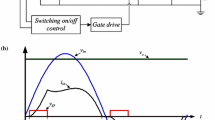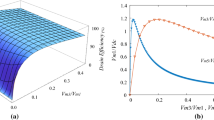Abstract
In this paper, rigorous analytical derivation of the coefficients of optimal current waveform for class-F power amplifier (PA) up to fourth harmonic (dc, 1st, 2nd and 4th harmonic) is presented. The coefficients of the optimal current waveform along with related maximum attainable efficiency are provided in closed form. The results obtained are also of interest for the inverse class-F, in the case when optimal voltage waveform consists of dc, 1st, 2nd and 4th harmonic.

Similar content being viewed by others
References
Abe Y, Ishikawa R and Honjo K 2008 Inverse class-F AlGaN/GaN HEMT microwave amplifier based on lumped element circuit synthesis method. IEEE Trans. Microw. Theory Tech. 56: 2748–2753
Bogaevsky I A 2002 Perestroikas of shocks and singularities of the minimum functions. Physica D 173: 1–28
Carrubba V, Clarke A L, Akmal M, Lees J, Benedikt J, Tasker P J and Cripps S C 2011 On the extension of the continuous class-F mode power amplifier. IEEE Trans. Microw. Theory Tech. 59: 1294–1303
Carrubba V, Akmal M, Quay R, Lees J, Benedikt J, Cripps S C and Tasker P J 2012 The continuous inverse class-F mode with resistive second-harmonic impedance. IEEE Trans. Microw. Theory Tech. 60: 1928–1936
Chen K and Peroulis D 2012 Design of broadband highly efficient harmonic-tuned power amplifier using in-band continuous class-F−1/F mode transferring. IEEE Trans. Microw. Theory Tech. 60: 4107–4116
Cripps S C 2010 Grazing zero [microwave bytes]. IEEE Microw. Mag. 11(7): 24–34
Cripps S C, Tasker P J, Clarke A L, Lees J and Benedikt J 2009 On the continuity of high efficiency modes in linear RF power amplifiers. IEEE Microw. Wireless Compon. Lett. 19: 665–667
Fejer L 1916 Über trigonometrische polynome. (in German). J. Reine Angew. Math. 146: 53–82
Juhas A and Novak L A 2009 Comments on “Class-E, class-C, and class-F power amplifier based upon a finite number of harmonics”. IEEE Trans. Microw. Theory Tech. 57: 1623–1625
Juhas A and Novak L A 2013 Maximally flat waveforms with finite number of harmonics in class-F power amplifiers. Math. Probl. Eng. 2013: Article ID 169590, 9 pages
Juhas A and Novak L A 2014 General description of nonnegative waveforms up to second harmonic for power amplifier modelling. Math. Probl. Eng. 2014: Article ID 709762, 18 pages
Kim J H, Jo G D, Oh J H, Kim Y H, Lee K C and Jung J H 2011 Modeling and design methodology of high-efficiency class-F and class-F−1 power amplifiers. IEEE Trans. Microw. Theory Tech. 59: 153–165
Moon J, Jee S, Kim J, Kim J and Kim B 2012 Behaviors of class-F and class-F−1 amplifiers. IEEE Trans. Microw. Theory Tech. 60: 1937–1951
Raab F H 2001a Maximum efficiency and output of class-F power amplifiers. IEEE Trans. Microw. Theory Tech. 49: 1162–1165
Raab F H 2001b Class-E, class-C and class-F power amplifiers based upon a finite number of harmonics. IEEE Trans. Microw. Theory Tech. 49: 1462–1468
Rhodes J D 2003 Output universality in maximum efficiency linear power amplifiers. Int. J. Circuit Theory Appl. 31: 385–405
Roberg M and Popovic Z 2011 Analysis of high-efficiency power amplifiers with arbitrary output harmonic terminations. IEEE Trans. Microw. Theory Tech. 59: 2037–2048
Schmelzer D and Long S I 2007 A GaN HEMT class F amplifier at 2GHz with 80% PAE. IEEE J. Solid-State Circuits 42: 2130–2136
Tasker P J 2009 Practical waveform engineering. IEEE Microw. Mag. 10(7): 65–76
Tasker P J and Benedikt J 2011 Waveform inspired models and the harmonic balance emulator. IEEE Microw. Mag. 12(2): 38–54
Woo Y Y, Yang Y and Kim B 2006 Analysis and experiments for high-efficiency class-F and inverse class-F power amplifiers. IEEE Trans. Microw. Theory Tech. 54: 1969–1974
Wren M and Brazil T J 2005 Experimental class-F power amplifier design using computationally efficient and accurate large-signal pHEMT model. IEEE Trans. Microw. Theory Tech. 53: 1723–1731
Acknowledgements
This work is supported by Serbian Ministry of Education, Science and Technology Development as a part of the Project TP32016.
Author information
Authors and Affiliations
Corresponding author
Appendix A
Appendix A
Full account of details of derivation of (17) and (18) (Section 2) is provided in this appendix.
From (11), (13) and (15) we obtain
Combining (A.1) and (12) yields
whereas combining (A.1) and (14) yields
According to (A.1), x 1 and x 3 are not simultaneously equal to zero, since otherwise, it would lead to x 0 = x 2 = x 4 = 0, which together with x 1 = x 3 = 0 contradicts (8).
Equations (A.2) and (A.3) can be considered as a system of linear equations in terms of \((2-{\lambda _{1}^{2}} +{\lambda _{2}^{2}})\) and (1+2λ2). Thus we have the following two cases: either (i) \({x_{1}^{2}} -{x_{3}^{2}} =0\) or (ii) \({x_{1}^{2}} -{x_{3}^{2}} \ne 0\). In what follows we show that case (i) leads to contradiction, while case (ii) leads to the optimal waveform given by (19).
(i) From x 1 = ± x 3, taking into account that at least one of x 1 and x 3 is not equal to zero, it follows that x 1 ≠ 0 and x 3 ≠ 0. Substitution of x 1 = ± x 3 into (A.1) leads to x 0 = ± x 4. Furthermore, inserting x 1 = ± x 3 and x 0 = ± x 4 into (9) implies x 0 = x 4 = 0, since x 1 ≠ 0. This contradict our assumption that A 4 = 2x 0 x 4 ≠ 0.
(ii) The determinant of the system (A.2)–(A.3) is non-zero and consequently it has trivial solution only: \(2-{\lambda _{1}^{2}} +{\lambda _{2}^{2}} =0\) and 1+2λ2 = 0, that is,
Since A 1>0, from (16) and (A.4) it follows that (17) holds. Substituting λ1 = −A 1 = −3/2 and λ2 = −1/2 into (A.1) we obtain
From (2), using (A.5), it follows that
From (A.5), (A.6) and (5) it follows that
Finally, substituting (A.5)–(A.7) into (4) and (6) leads to (18).
Rights and permissions
About this article
Cite this article
JUHAS, A., NOVAK, L.A. Closed form of optimal current waveform for class-F PA up to fourth harmonic. Sadhana 40, 425–436 (2015). https://doi.org/10.1007/s12046-015-0339-9
Received:
Revised:
Accepted:
Published:
Issue Date:
DOI: https://doi.org/10.1007/s12046-015-0339-9




